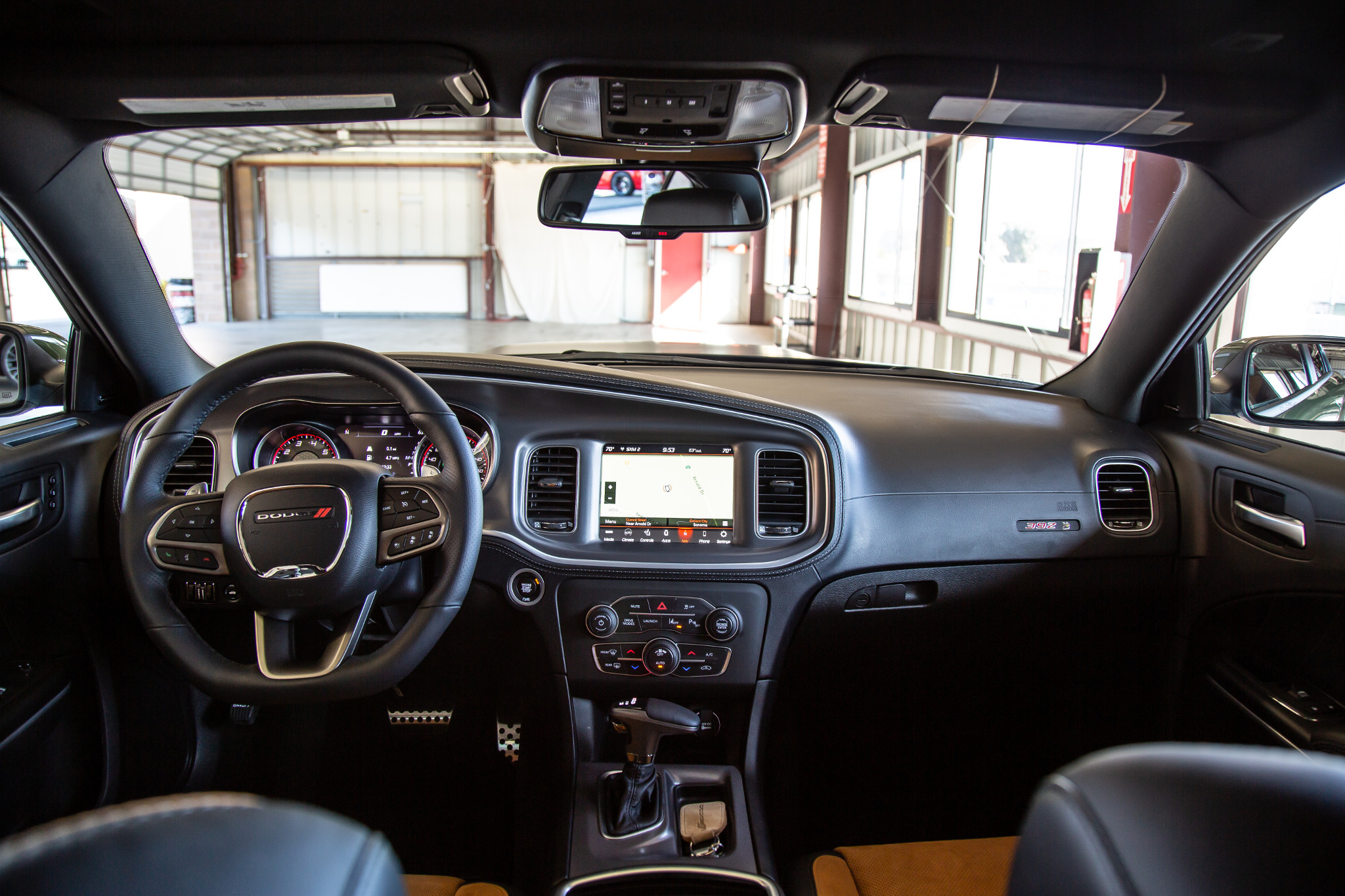The Dodge Charger is a muscle car with the added convenience of having four doors and a roomy backseat. This is a performance machine with old-school charm, and it’s really big and incredibly quick — especially in its Scat Pack and SRT Hellcat incarnations. Couple what’s under the hood with the Widebody suspension upgrade, and you have the makings of a performance machine that’s not only crazy-quick in a straight line, but one that attacks corners with far more confidence than before.
Related: 2020 Dodge Charger Scat Pack and Hellcat Widebody: Which to Buy?
We recently got behind the wheel of the Scat Pack and Hellcat Widebody to see for ourselves how this wider, more planted suspension affects this Dodge sedan’s behavior both on public roads and on a racetrack. You can get our full impressions by following the related link above, but for a tire-smoking quick take on this pair of muscle sedans, keep reading.
Here are seven things that get us all charged up, and three where our enthusiasm loses charge, about the 2020 Dodge Charger Scat Pack and Hellcat Widebody:
Things We Like
1. Power, and Lots of It
It’s rare that a 485-horsepower, 6.4-liter V-8 gets overshadowed by something even more powerful and entertaining. Don’t get us wrong, the Scat Pack Widebody has plenty of firepower and needs only 4.3 seconds to accelerate from 0 to 60 mph. Bottom line, though: The 707-hp, supercharged 6.2-liter Hemi V-8 in the Hellcat tends to put everything else to shame. Getting the perfect launch isn’t easy, but Dodge estimates the Hellcat Widebody needs only 3.6 seconds for the same 0-60 mph sprint. (It also wails like a banshee when the throttle is floored.)
2. Massive Tires
The rear wheels on the Charger Scat Pack and Hellcat Widebody measure in at a steamroller-like 11 inches in width. That’s up from the already prodigious 9.5-inch-wide rear wheels fitted previously. The 20-inch tires are sticky Pirelli P-Zero all-season radials; for even more grip, get the optional summer tires.
3. Superb Suspension Upgrade
The Widebody package doesn’t stop at bigger wheels and wider fenders. Dodge went to great lengths to make certain this handling upgrade was a lot more than extra rubber on the road. Adaptive shock absorbers, larger sway bars and significantly stiffer springs give the Charger Widebody models the added poise you want when unleashing this much horsepower.
4. Electric Power Steering Doesn’t Wilt on the Track
We were concerned that the addition of electric power steering would make the Charger feel vague and lifeless, particularly when pushing hard on a racetrack. Dodge changed to electric power steering because the Widebody suspension would have overwhelmed the hydraulic system used before. Thankfully, the steering in both versions of the Charger is more than up to the task.
5. Docile When Cruising
Believe it or not, both of these muscle sedans are teddy bears when you want to cruise sedately. The long wheelbase helps cushion the ride even with the more firm Widebody suspension hardware. Each V-8 engine is awfully quiet when you’re not hammering the gas pedal, too; the subdued burbles and growls are there, but you won’t need to pack aspirin for long drives.
6. More Confidence When You Pin the Gas Pedal
The Widebody upgrade gives the driver a lot more confidence, especially when rolling back onto the gas pedal in the middle of a curve. Trust us, the Hellcat is still a test of your bravery — you just no longer feel like you’re perpetually on a razor’s edge.
7. An Everyday User-Friendly Muscle Car
We know these Dodge sedans are big and have a hefty appetite for fuel, and if you’re not careful, the potential for speeding tickets could turn you into the biggest donor to your local police department. But in terms of ride comfort, cargo space, passenger room and even its user-friendly infotainment system, the Dodge Charger is a practical piece of high-performance machinery.
More From Cars.com:
- Shopping for a 2020 Dodge Charger? Research One, Here
- Find a 2020 Dodge Charger for Sale Near You, Now
- 2019-2020 Dodge Charger: Everything You Need to Know
- Dodge Flexes Its Winter Muscle With 2020 Charger GT AWD
- Find Your Next Car
Things We Don’t
1. Hellcat Hath High Price
You didn’t expect a sedan with 707 hp to be a bargain, right? The Hellcat Widebody we tested carried a sticker price of $79,410; that made it roughly $18,000 more expensive than the Scat Pack version we drove alongside it. Granted, you’re not buying cars like these out of an abundance of economic prudence, but the Hellcat’s price could be a tough pill to swallow even for Dodge diehards.
2. Do You Really Need 707 HP?
Yes, yes you do … and no, you really don’t. As car enthusiasts, we’re never going to turn down the opportunity to drive something as wildly overpowered as a Dodge Hellcat of any kind. But if we’re being honest, the 485 hp you get in the Scat Pack is more than enough for any road or racetrack.
3. Hope You Measured Your Garage First
This one’s only a ding against the Widebody for those with non-negotiable space concerns. The Charger in any form is a big car. With the Widebody upgrade making it 3 inches wider, well, you might want to make certain you have enough acreage to park this big Dodge in your garage or in your assigned spot.
Cars.com’s Editorial department is your source for automotive news and reviews. In line with Cars.com’s long-standing ethics policy, editors and reviewers don’t accept gifts or free trips from automakers. The Editorial department is independent of Cars.com’s advertising, sales and sponsored content departments.
Source: Read Full Article






